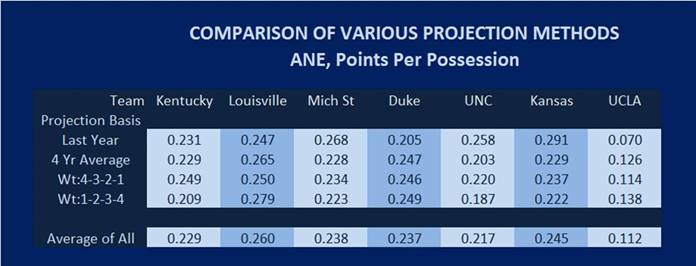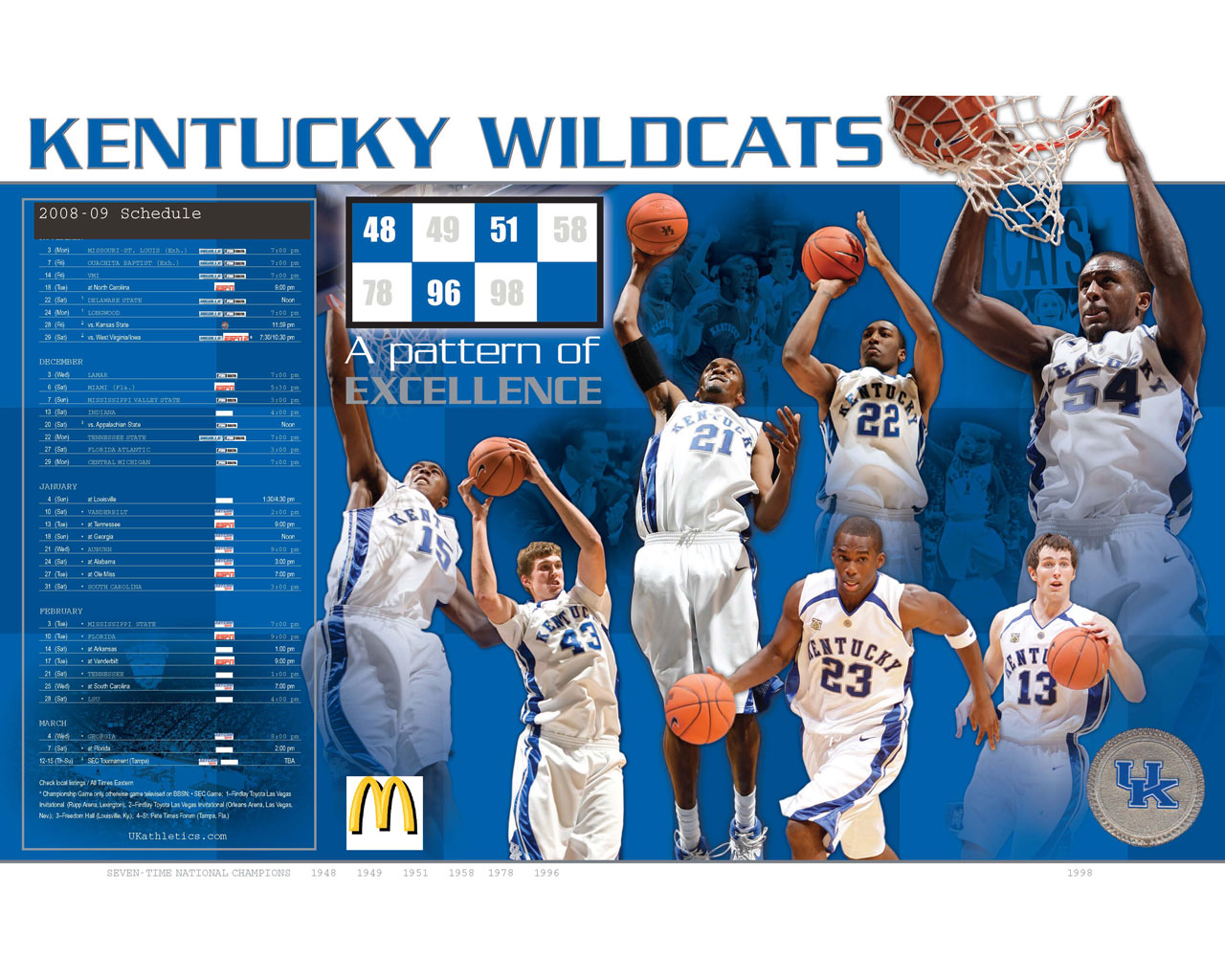BIG BLUE FANS FOR

BASKETBALL
2016-17 Season Analytical Writings
00
A LOOK AT KENTUCKY'S 2016-17 NON-CONFERENCE OPPONENTS
Kentucky's 2016-17 non-conference basketball schedule would be challenging for any team in any season. The reason is simple to understand. Kentucky, UNC, Kansas, Louisville, Duke (yes, they are not on this schedule), and Michigan State represent the best of the best year in and year out. It is entirely fitting that UK play these programs on a regular basis, including them on schedules most if not all seasons.
I have pulled the statistics for 2012-13 through 2015-16 for Kentucky and each of these prominent, perennial national contenders, and plotted their respective ANE values for these 4 seasons. Since many observers also place UCLA in their lists of major national programs, and since UK and UCLA will meet this year for the 3 rd straight year, I added UCLA in this presentation. In addition, while Duke is not on this year's schedule, Duke is a part of this presentation. Duke competes in the four-team Champions Classic, and according to most observers, Duke is UK's major competitor on the recruiting trail and court moving forward.

A quick look at the results confirms my observations that UCLA is a pretender. UCLA's level of performance over the last 4 years (and more than that, if the truth be known) has not been sufficient to place UCLA on equal footing with the other six programs included in this presentation. I understand that other programs could make valid claims to inclusion. For example, Arizona, UConn, Syracuse, Wisconsin, and others can make stronger arguments than those available to justify UCLA's inclusion here. However, the six programs highlighted here, Kentucky, Louisville, Duke, UNC, Michigan State, and Kansas, have played on the national stage not just for 4 seasons, but for four or more decades without significant absence. That is why these 4-season trends must be viewed within the context of a 20+ year program trend. I only have the data for UK in this broader context as shown below:

Each of these six, except Louisville, shows a rising trend over the last four seasons (Duke is horizontal). Louisville's declining four-year trend results more from its 2013 championship season, and a similar presentation following the 2016-17 season is likely to shift Louisville to a rising trend after the 2013 championship season falls from the analysis. Even with its decline from its Championship form of 2013, Louisville has remained in the “hunt.” These six programs continue to define college basketball, and UK will play four of the other five this year.
These ANE trends provide an important benchmark for these teams regarding reasonable expectations for the future, most notably the 2016-17 season. In order to forecast an upcoming season, it is necessary to establish a reasonable estimate (guess) about team strength. All rating systems do this to establish the starting point for a season. I am sharing here the methodology I use for the 2016-17 season. The assumptions used by the various published systems are generally unknown because each of them, including Pomeroy and Sagarin, consider their method proprietary, and probably superior to other methods. However, I believe that each of them use one, or a close derivative of one of these 4 methods.
I believe Pomeroy uses a weighted average going back some unknown number of years. In addition, Pomeroy probably does not include any of his subtle adjustments such as schedule strength, venue, luck, or any other massaging tool he may use during the season. Therefore, Pomeroy's absolute values in the pre-season tend to be lower for top teams than the final strengths of the top tier of teams. I believe Sagarin also uses an average of recent seasons. I do not know how many seasons he uses, and he may use a weighting as well. In contrast to Pomeroy, Sagarin's starting values more closely reflect the full range of values that will exist, top to bottom, at the end of the season.
No method can predict which of the top tier teams will rise from the pack by distinguishing itself on the court. Some of the top tier will rise; others will slip, but I am confident that this top tier field will be in the hunt.
In the past, I have used the prior season statistics as the starting point for a new season. In recent years, I have been examining an average of the past four years, both arithmetic and weightings of various schemes. The “average” method is the arithmetic average of the most recent four seasons. The 4-3-2-1 weighting places more value on the more recent seasons, less or the more distant seasons, and no significance on any season more than 4 years old. The 1-2-3-4 weighting places more value on the season 4 years past, less value on last season, and no significance on any season more than 4 years old. For teams with a rising trend, the 4-3-2-1 method will indicate higher future values than the 1-2-3-4 method, and vice versa.
The following Table provides “starting” values for ANE for the seven teams identified in the 4-year trend graph above using these four methods.

I am struck first by the relative uniformity that exists for any given team. Using UCLA as an example, this uniformity is not limited to the great programs, but occurs throughout the full set of teams, top to bottom because major change, up or down, one year to the next, are extremely rare.
All of this also applies to football. This explains why UK/Stoops faces such a daunting job to move UK Football from the SEC doormat to SEC respectability. It also makes the same task for someone like Bruce Pearl at Auburn, for example, so incredibly difficult. This does not mean that Stoops or Pearl is a failure, but speaks to the baseline level against which they must start and fight to improve.
For UK Football or Auburn Basketball to move up in a structural manner it must establish a new baseline. However, that is easier said than done because if one team does establish a new baseline at a substantially higher level, another team must structurally fall to a new lower baseline. However, make no mistake that each of those coaches are working day and night, not just to prevent their own programs' baseline from falling, but in fact they are working hard to make their programs' baseline rise too.
Fans are not so analytical, and fans expect, indeed demand that their coach affect the rise now. Otherwise, fans will quickly conclude that their coach is incapable and insist on another coach “who can get it done.” In my opinion, programs and coaches would be better served if fans could be more patient. For example, has the UK baseline changed over the last 5 years, up or down, or is it the same. If it is the same or falling, a coaching change may be legitimate. However, if the baseline is rising, continued patience with the coach and his staff may be justified.
Similarly, for UK basketball, the “fall” that occurred by Sutton's debacle was not structural but temporal, and Pitino could quickly “fix” the short term issue because the baseline did not change due to Sutton's troubles. Pitino quickly reestablished that baseline, and actually raised it a notch or two by the mid 1990s. In contract, the 10 years with Tubby Smith did cause a structural decline in the UK Basketball baseline. The two-year experiment with Gillispie did not reverse that trend. Probably, John Calipari is the only coach that could enter the UK picture and re-establish a higher UK baseline so quickly.
I repeat one more time. The problem with UK football has rarely been the name of the coach. The problem is the programmatic baseline that the administration has been supporting for decades. Similarly, the success of UK basketball rarely falters with coaching changes because the programmatic baseline that the UK administration, not just supports, but demands, has been in place for decades.
I believe these ideas reflect my overall philosophy about college football and basketball and has defined how I look at the UK programs. I expect UK basketball to compete for championships every year. I hope UK football can win more games than it loses every year.
Submitted by Richard Cheeks


Submitted by Richard Cheeks
![]()
Copyright 2016
SugarHill Communications of Kentucky
All Rights Reserved